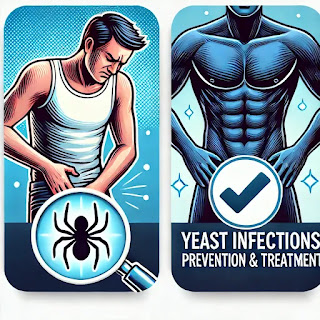Introduction: Yes, Men Can Get Yeast Infections Too
When people hear "yeast infection," they often associate it with women. But did you know that men can get them too? Yeast infections in men, also known as male candidiasis, are more common than you might think. These infections can cause itching, redness, discomfort, and even pain if left untreated.
The good news? Yeast infections are preventable and treatable. Whether you're dealing with an infection right now or looking for ways to avoid one in the future, this guide will help you understand the causes, symptoms, treatments, and prevention strategies.
What Causes Yeast Infections in Men?
Yeast infections are caused by an overgrowth of Candida, a type of fungus that naturally lives on your skin and in your body. When the balance of bacteria and yeast is disrupted, Candida can multiply, leading to an infection.
Common Causes:
- Poor hygiene: Not cleaning the genital area properly can lead to yeast buildup.
- Unprotected sex: Yeast infections are not considered STIs, but they can spread through sexual contact.
- Diabetes: High blood sugar levels create an environment where yeast thrives.
- Antibiotics: These kill good bacteria that keep yeast in check.
- Weakened immune system: Conditions like HIV or prolonged illness can increase infection risk.
- Tight, non-breathable clothing: Traps moisture, creating a perfect environment for yeast growth.
- Obesity: Skin folds can trap moisture and heat, promoting yeast infections.
Symptoms of a Yeast Infection in Men
Yeast infections in men primarily affect the genital area (penile candidiasis), but symptoms can also appear in other parts of the body, such as the mouth (oral thrush) or skin folds.
Common Symptoms of Penile Yeast Infection:
- Redness and irritation on the head of the penis
- Itching or burning sensation
- White, lumpy discharge under the foreskin
- Unpleasant odor
- Pain or discomfort during urination or intercourse
Symptoms of Oral Thrush:
- White patches in the mouth or on the tongue
- Soreness or difficulty swallowing
If left untreated, a yeast infection can lead to balanitis (inflammation of the penis head) and more severe discomfort.
How to Treat a Yeast Infection in Men
If you suspect you have a yeast infection, the first step is not to panic—it’s common and treatable. Here’s what you can do:
1. Over-the-Counter Antifungal Treatments
The most effective treatment for a yeast infection is an antifungal cream, such as:
- Clotrimazole (Lotrimin, Canesten)
- Miconazole (Monistat, Micatin)
💡 How to Use: Apply the cream to the affected area twice daily for 7-14 days, even if symptoms improve earlier.
2. Prescription Medications (For Severe Cases)
If an OTC cream isn’t effective, a doctor may prescribe:
- Oral antifungal medication (Fluconazole, single-dose pill)
- Stronger topical antifungals
3. Home Remedies (Supportive Care)
While antifungal creams are the gold standard, some natural remedies may help soothe symptoms:
- Yogurt & Probiotics: Contain beneficial bacteria that help restore balance.
- Coconut Oil: Has antifungal properties—apply a small amount to the area.
- Apple Cider Vinegar (Diluted): A gentle rinse may help kill excess yeast.
- Tea Tree Oil (Diluted): Can be applied topically, but use with caution as it may cause irritation.
4. Maintain Proper Hygiene
- Wash the affected area with mild soap and water daily.
- Keep the area dry—moisture promotes yeast growth.
- Wear loose, breathable cotton underwear.
🚨 When to See a Doctor: If symptoms persist after treatment or worsen, consult a healthcare provider.
How to Prevent Yeast Infections in Men
Preventing a yeast infection is easier than treating one. Here are some practical steps to reduce your risk:
1. Practice Good Hygiene
- Wash your genital area daily with mild soap.
- Dry thoroughly before getting dressed.
- Avoid using heavily scented soaps or body washes.
2. Manage Blood Sugar Levels
- If you have diabetes, keep your blood sugar in check.
- Avoid excessive consumption of sugary foods and drinks.
3. Choose Breathable Clothing
- Wear cotton underwear and loose-fitting clothes.
- Avoid tight, synthetic fabrics that trap moisture.
4. Strengthen Your Immune System
- Eat a balanced diet rich in vegetables, lean proteins, and probiotics.
- Exercise regularly.
- Get enough sleep and manage stress levels.
5. Be Cautious with Antibiotics
- Only take antibiotics when prescribed.
- Consider taking probiotics to maintain healthy bacteria levels.
6. Use Protection During Sex
- Yeast infections can spread through sexual contact.
- Clean up after intimacy and practice safe hygiene.
FAQs About Yeast Infections in Men
Can a Man Pass a Yeast Infection to His Partner?
Yes, yeast infections can be passed through sexual contact. If one partner has symptoms, both should consider treatment to prevent reinfection.
Can Yeast Infections Go Away on Their Own?
Mild cases may resolve, but treatment speeds up recovery and prevents complications.
Can I Still Have Sex If I Have a Yeast Infection?
It’s best to wait until the infection clears to avoid irritation and passing it to your partner.
How Long Does It Take to Heal?
With proper treatment, symptoms usually improve within a few days to a week.
Conclusion: Take Control of Your Health
Yeast infections in men are common but manageable with the right approach. By practicing good hygiene, making smart lifestyle choices, and seeking treatment early, you can prevent and treat yeast infections effectively.
If you’re experiencing symptoms, don’t ignore them—simple treatments can bring relief quickly. And if infections keep recurring, a doctor can help identify underlying causes.
💡 Stay informed, stay clean, and stay healthy! If you found this guide helpful, share it with someone who might need it. 🚀





0 Comments